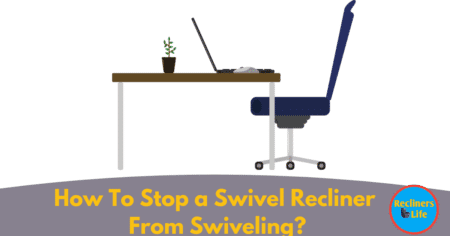If you work from home or spend a lot of time sitting at your desk, you might be wondering if you can use a recliner as an office chair.
After all, recliners are designed to provide comfort and relaxation, right? Well, not exactly.
While recliners may seem tempting, they are not the best choice for your health, productivity, or ergonomics.
In this article, we will explain why you should not use a recliner as an office chair, and what are some better alternatives.
Why You Should Not Use a Recliner as an Office Chair?
While recliners offer unmatched relaxation for watching movies or reading, they might not be the best choice for extended office work. Here’s why:
1. Ergonomics and Posture
Recliners are designed with relaxation in mind, not proper ergonomics. Office chairs are designed to support the spine’s natural curvature and maintain good posture.
Recliners, on the other hand, encourage a more relaxed and laid-back posture, which can lead to discomfort, strained muscles, and even long-term spinal issues.
2. Lack of Lumbar Support
A crucial element in ergonomic office chairs is lumbar support.

Recliners typically lack this feature, causing your lower back to arch uncomfortably, leading to lower back pain and discomfort over time.
3. Neck Strain
Recliners don’t usually have adjustable headrests, which can strain your neck when you’re working on a computer or reading documents. This can lead to neck pain and reduced productivity.
4. Limited Adjustability
Office chairs often offer a variety of adjustments like seat height, armrest height, and tilt. Recliners, however, usually lack these adjustable features, making it challenging to find the optimal position for your work.
What Are Some Alternatives to Recliners for Office Work?
If you’re looking for comfort without sacrificing productivity and health, there are alternatives to recliners:
- Ergonomic Office Chairs: These chairs are specifically designed to provide proper support and promote good posture during long work hours. They come with adjustable features to customize your seating position for maximum comfort.
- Kneeling Chairs: Kneeling chairs encourage a more upright posture by distributing your body weight between your knees and buttocks. This helps alleviate back pain and strain.
- Exercise Balls: Stability balls engage your core muscles while you sit, promoting better posture and reducing the risk of back pain. However, they might not be suitable for long hours of work.
- Standing Desks with Stools: Combining standing intervals with seated breaks on a stool can provide a balance between comfort and activity, promoting better blood circulation and reducing sedentary behavior.
Pros and Cons of Recliner as an Office Chair
| Pros | Cons |
|---|---|
| Luxurious comfort | Poor ergonomics |
| Relaxation | Lack of lumbar support |
| Style and aesthetics | Neck strain |
| Limited movement freedom | Limited adjustability |
| Unconventional work setup | Reduced productivity |
Considerations For Using A Recliner as an Office Chair
When contemplating using a recliner as an office chair, consider the following:
- Work Nature: If your job involves focused computer work, a recliner might not provide the necessary support for extended periods of concentration.
- Physical Health: If you already experience back or neck pain, using a recliner could exacerbate these issues.
- Productivity: A recliner’s comfort might lead to a more laid-back approach to work, affecting your efficiency and output.
- Comfort vs. Functionality: Finding the balance between comfort and functionality is essential. Prioritize a chair that supports both your comfort and work needs.
Conclusion
While the allure of working from a recliner might seem tempting, the practicality of using it as an office chair comes with certain drawbacks.
Ergonomic office chairs are designed to provide the necessary support and comfort needed for prolonged work hours. Ultimately, the decision depends on your work requirements, health considerations, and personal preferences.
For a healthier and more productive work experience, investing in a well-designed ergonomic office chair is likely the wiser choice.
Frequently Asked Questions
Is Recliner Good for Office Work?
Using a recliner for office work is not advisable. While recliners offer comfort, they lack the ergonomic design needed for extended work periods.
Their relaxed posture can cause discomfort, strained muscles, and potential long-term health issues.
What Is the Difference Between a Recliner Chair and an Office Chair?
Recliner chairs prioritize leisure, with plush seats and the ability to recline. They don’t provide the posture support needed for work.
Office chairs prioritize ergonomics, offering lumbar support, adjustable features, and spine-friendly design for prolonged work comfort.
Recliner vs. Office Chair: Which Is Better?
For office work, the office chair wins. It offers ergonomic support and promotes proper posture, crucial for avoiding back and neck pain during long work hours.
While recliners are comfy for leisure, they lack the features needed for a productive and healthy work setup. If comfort and work functionality matter, opt for an ergonomic office chair.

